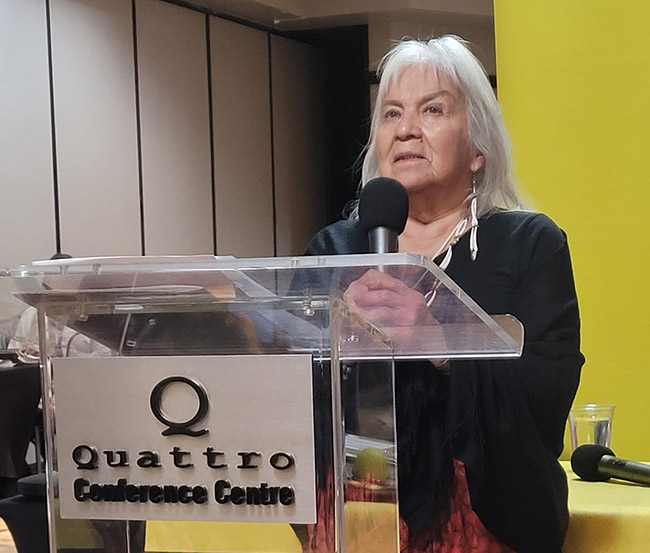E’Dbendaagzijig declaration drafted at gathering

By Kirk Titmuss
SAULT STE. MARIE – A hard-driving snowstorm failed to deter over 50 Anishinabek Nation citizens, Chiefs, staff, and B’Maakonigan First Nations representatives from attending the E’Dbendaagzijig (Citizenship) Gathering held in Baawaating Traditional Territory, Sault Ste. Marie, Ont., on January 29, organized to create a draft E’Dbendaagzijig Declaration, the precursor to a E’Dbendaagzijig Naaknigewan (Citizenship Law).
As part of the citizenship theme, meeting room tables were set up with accompanying doodemaag (clans) banners. Attendees were encouraged to sit at the table corresponding their respective doodem (clan).
Grand Council Chief Linda Debassige was pleased with the turnout and what the gathering meant to the Anishinabek Nation communities looking to usher in their own citizenship laws down the road.
“This session today provides an opportunity for us to touch base with one another to talk about the challenges, concerns, competing factors, and talk through those with a whole goal of developing a declaration specific to E’Dbendaagzijig and its foundation, which would be Ngo Dwe Waangizid Anishinaabe (One Anishinaabe Family). So really, advancing that yardstick beyond the Indian Act and helping our communities – our 39 communities – establish their own law and we help support the work needed for them to fully assume that jurisdiction.”
Guest speaker E’Dbendaagzijig Commissioner Jeannette Corbiere Lavell, an Anishinaabe educator and activist, was encouraged by the future possibilities the gathering represents for citizenship within the Anishinabek Nation.
Corbiere Lavell is no stranger to battling the federal government over citizenship, specifically enfranchisement, where women marrying into another community or a non-Indigenous man, lost their Indigenous status and were removed from Canada’s Indian Register.
In 1970, Corbiere Lavell lost her status after her marriage to a non-Indigenous man. She challenged section 12 of the Indian Act on the basis that it was discriminatory. The case would go to the Supreme Court of Canada which ruled that the Bill of Rights did not apply to that section of the Indian Act. However, in 1985 section 12 of the Indian Act was repealed, validating Corbiere Lavell’s challenge.
“This is our opportunity to really put our energies together to decide upon our one-parent rule for E’Dbendaagzijig and that’s what we’re going to be stressing and hopefully what will come out of this is a strong declaration of E’Dbendaagzijig Naaknigewin, which will be our citizenship law and we can take that and share it with other First Nations and the governments, the two levels of government so they know we’re serious. We don’t want to be dictated to or come under their planning for our demise,” she stated.


